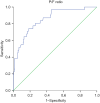Use of the PaO2/FiO2 ratio in acute pulmonary embolism: a simple and reliable parameter to predict the risk stratification
- PMID: 40809218
- PMCID: PMC12340331
- DOI: 10.21037/jtd-24-1821
Use of the PaO2/FiO2 ratio in acute pulmonary embolism: a simple and reliable parameter to predict the risk stratification
Abstract
Background: Acute pulmonary embolism (APE) is a common pulmonary vascular disease with its incidence rising year by year. Accurate diagnosis and early risk stratification of patients with APE are crucial for treatment follow-up, especially for patients with intermediate-to-high and high-risk. The aim of this study is to explore the value of blood gas parameters, especially arterial partial pressure of oxygen/fraction of inspired oxygen (PaO2/FiO2) ratio (P/F ratio), in evaluating the risk stratification of APE.
Methods: A retrospective analysis of demographic data, complications, clinical symptoms, and laboratory data of 227 adult patients with APE treated at Ruijin Hospital, Shanghai Jiao Tong University School of Medicine Ruijin Hospital, from January 2016 to December 2021 was conducted. According to risk stratification, patients were divided into the intermediate-low risk and below group (low-risk group and intermediate-low-risk group), intermediate-high-risk and above group (intermediate-high-risk group and high-risk group), and the correlation between various indicators and risk stratification of APE was analyzed. Multivariate binary logistic regression was used to identify independent influencing factors for intermediate-high-risk and high-risk APE; receiver operating characteristic (ROC) curve analysis was used to evaluate the efficacy of P/F ratio in assessing intermediate-high-risk and high-risk APE.
Results: There were significant differences in dyspnea, syncope, and fever among the two groups (P<0.05). There were significant differences in P/F ratio, partial pressure of carbon dioxide (PaCO2), pulse oxygen saturation/fraction of inspired oxygen (SpO2/FiO2) among the two groups (P<0.05). Correlation analysis showed that dyspnea, syncope, fever, P/F ratio, PaCO2, and SpO2/FiO2 were correlated with the risk stratification (P<0.05). Multivariate binary logistic regression analysis showed that P/F ratio was an independent risk factor for intermediate-high-risk and high-risk APE (P=0.01). The area under the curve (AUC) of P/F ratio for predicting APE in the intermediate-high-risk group and the high-risk group was 0.850, the cut-off value was 256.41, the sensitivity was 74.2%, and the specificity was 81.6%.
Conclusions: The P/F ratio has certain evaluative value in risk stratification of APE and can serve as a rapid and convenient method for predicting intermediate-high-risk and high-risk APE.
Keywords: Pulmonary embolism (PE); blood gas analysis; oxygen saturation; retrospective studies; risk assessment.
Copyright © 2025 AME Publishing Company. All rights reserved.
Conflict of interest statement
Conflicts of Interest: All authors have completed the ICMJE uniform disclosure form (available at https://jtd.amegroups.com/article/view/10.21037/jtd-24-1821/coif). The authors have no conflicts of interest to declare.
Figures
Similar articles
-
Catheter-directed therapies for the treatment of high risk (massive) and intermediate risk (submassive) acute pulmonary embolism.Cochrane Database Syst Rev. 2022 Aug 8;8(8):CD013083. doi: 10.1002/14651858.CD013083.pub2. Cochrane Database Syst Rev. 2022. PMID: 35938605 Free PMC article.
-
Prescription of Controlled Substances: Benefits and Risks.2025 Jul 6. In: StatPearls [Internet]. Treasure Island (FL): StatPearls Publishing; 2025 Jan–. 2025 Jul 6. In: StatPearls [Internet]. Treasure Island (FL): StatPearls Publishing; 2025 Jan–. PMID: 30726003 Free Books & Documents.
-
[Predictive value of plasma exosome count for the prognosis in septic patients].Zhonghua Wei Zhong Bing Ji Jiu Yi Xue. 2024 Jul;36(7):687-692. doi: 10.3760/cma.j.cn121430-20230717-00529. Zhonghua Wei Zhong Bing Ji Jiu Yi Xue. 2024. PMID: 39223881 Chinese.
-
Signs and symptoms to determine if a patient presenting in primary care or hospital outpatient settings has COVID-19.Cochrane Database Syst Rev. 2022 May 20;5(5):CD013665. doi: 10.1002/14651858.CD013665.pub3. Cochrane Database Syst Rev. 2022. PMID: 35593186 Free PMC article.
-
Sex as a prognostic factor for mortality in adults with acute symptomatic pulmonary embolism.Cochrane Database Syst Rev. 2025 Mar 20;3(3):CD013835. doi: 10.1002/14651858.CD013835.pub2. Cochrane Database Syst Rev. 2025. PMID: 40110896
References
LinkOut - more resources
Full Text Sources
Research Materials
Miscellaneous

